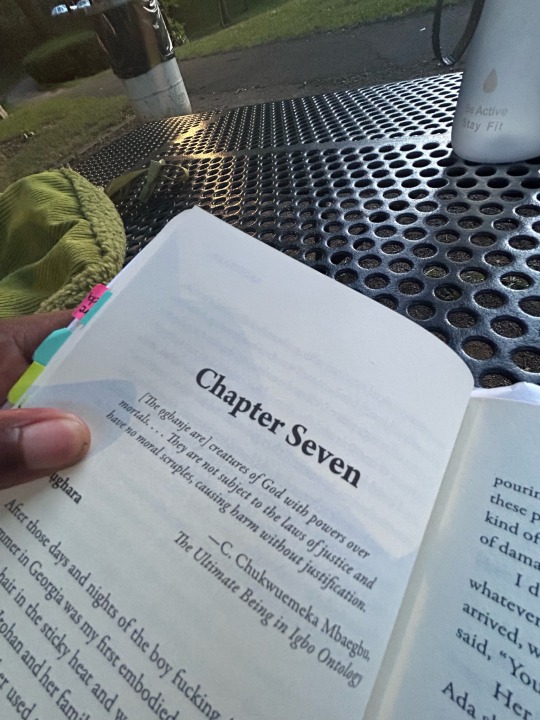#igbo mythology
Text
Randomly made a presentation on Igbo mythology so if anyone is interested in that for whatever reason here it is
a lot of the information is in the speakers notes
EDIT: updated link so presenter notes are hopefully accessible
31 notes
·
View notes
Text
So I had a really cool conversation with my grandpa about Kru folklore and religion. While we’re talking, he explains why the Kru gravitated towards Christianity easier than other tribes.
Apparently, we aren’t animists?
Which is insane, since so many West African traditions are, including the Vai and Bassa (my mom’s people).
Our religion, instead has only two figures (I’ll call them that because I’m not comfortable mapping Christian terminology onto it). One is called Nyeswa, “One who brings fish” a benevolent force and the other is Ku the more malevolent force. These two figures are equal in power and are equally worshipped. Ku is more so appeased than revered so as to prevent him from lashing out on humans.
So my grandpa reasons that since this narrative fit closely with Christian tradition, the fact that “God” and “Satan” aren’t on the same playing field made more Kru accepting. It was comforting to have the “devil” figure be subject in some capacity to Nyeswa, freeing humans from the burden of appeasing him.
The more you know!
#Liberia#sassywood#west africa#west African traditions#reconnecting indigenous#african religions#liberian#christianity#mythology#folklore#not#yoruba#but tagging for exposure here#the last supper#Igbo#west african indigenous#black history
5 notes
·
View notes
Text
12 famous African goddesses and gods with mind-blowing history - Briefly.co.za
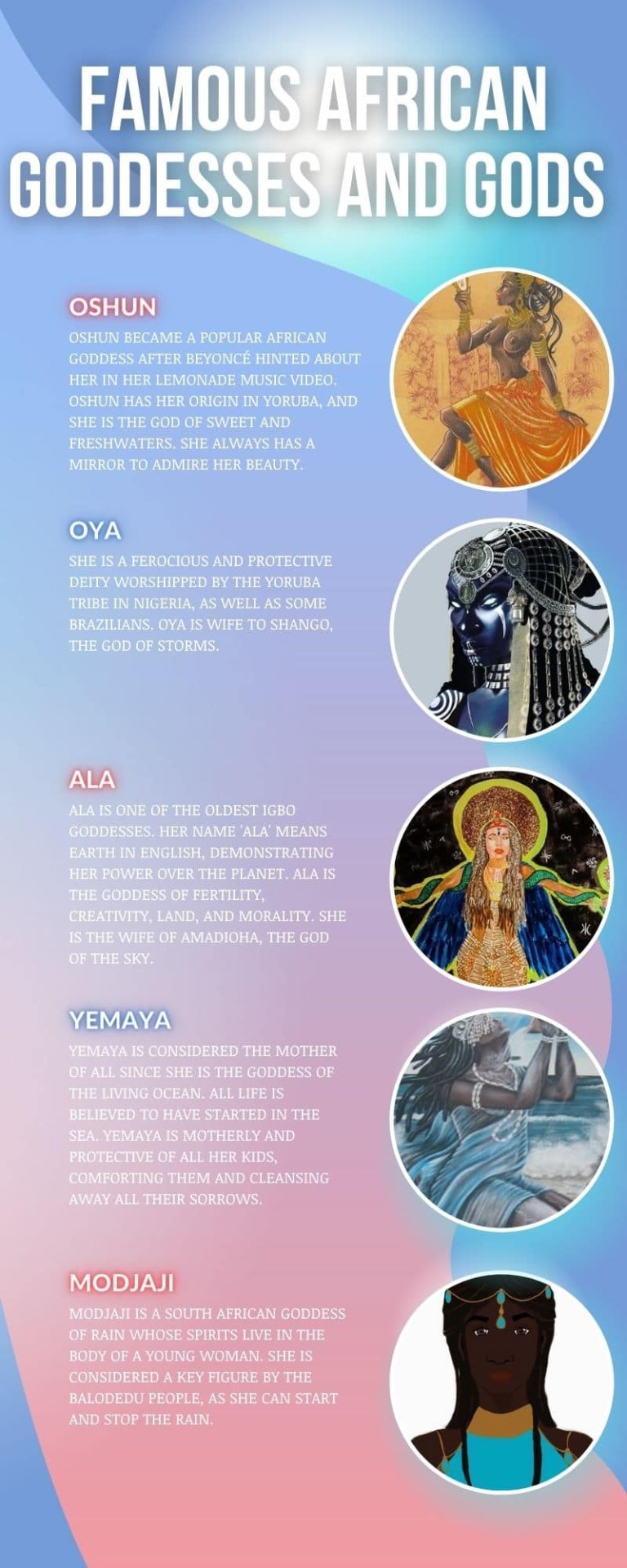
Most African cultures believe that God used to live amongst them in the past before He left for His Kingdom in Heaven after several human transgressions. In His place, He appointed lesser African gods and goddesses to perform certain functions. As such, Africans have the god of water, rains, winds, earth, and fire, among others, whom they can pray to directly, and they will intercede on God's behalf.
READ ALSO: Sotho culture, traditions, food, traditional attire, dance, values, and facts
12 African mythology gods and goddesses
Ever looked at African gods and goddesses pictures? These beings are considered powerful in different areas and in most cases. Their images reflect what they are associated with. Below we shall examine some of the famous African goddesses and gods with pictures and their meanings in their respective communities.
1. Oshun

Who is Oshun African goddess? Oshun became a popular African goddess after Beyoncé hinted about her in her Lemonade music video. Oshun has her origin in Yoruba, and she is the god of sweet and freshwaters. She always has a mirror to admire her beauty.
Oshun is revered by many for her abilities to heal the sick, foster prosperity, and bring fertility. The image of this goddess is represented by a stunning, charming, and coquettish young lady. Oshun means sweetness, joy, beauty, and good cheer.
2. Oya
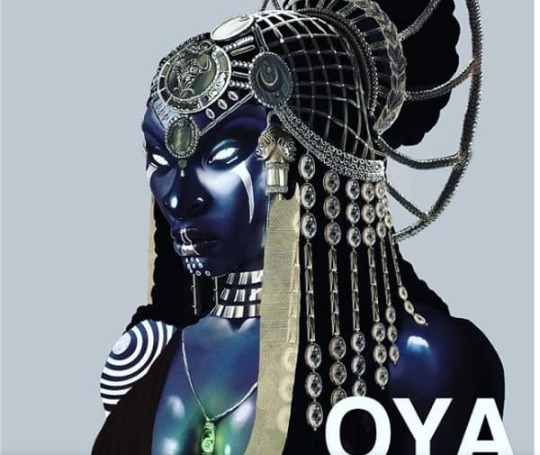
We cannot list African goddess names without including Oya. She is a ferocious and protective deity worshipped by the Yoruba tribe in Nigeria, as well as some Brazilians. Oya is wife to Shango, the god of storms. Oya is the goddess of wind, thunderbolt, and fire; she has the power to transform gentle breezes to raging hurricanes or cyclones. It is believed that she accompanies her husband during his thunderstorms to destroy buildings, blow things up, and rip off trees.
Due to her prowess, Oya brings down dead wood to give room for new. Additionally, she is the guardian of the gates of death, as she helps the dead in their transition from life.
3. Ala

Ala is one of the oldest Igbo goddesses. Her name 'Ala' means earth in English, demonstrating her power over the planet. Ala is the goddess of fertility, creativity, land, and morality. She is the wife of Amadioha, the god of the sky. This goddess is honored and celebrated during the yearly yam festival.
When angered, Ala will convince her husband to deny rain to the people and can also cause other natural disasters.
4. Yemaya
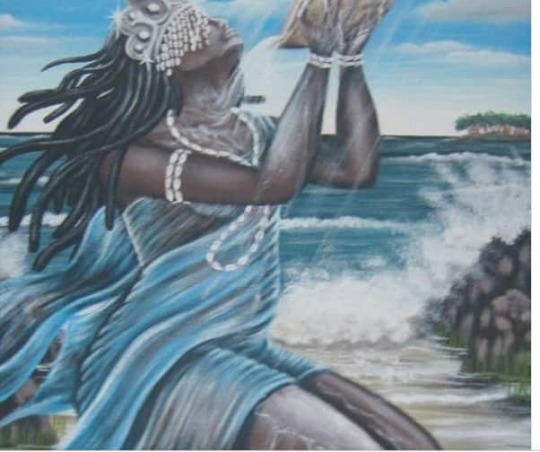
Yemaya is considered the mother of all since she is the goddess of the Living Ocean. All life is believed to have started in the sea. Yemaya is motherly and protective of all her kids, comforting them and cleansing away all their sorrows. It is thought she can cure infertility in women, and the cowrie shells symbolize her wealth.
Yemaya is not easily angered, but when she does, she is destructive and intense just as the sea during a storm.
5. Modjaji
Modjaji is a South African goddess of rain whose spirits live in the body of a young woman. She is considered a key figure by the Balodedu people, as she can start and stop the rain. The rain queen has been around for the longest time, and it was only in the 16th century that her spirit decided to dwell in a woman.
READ ALSO: Popular traditional black South African recipes and South African food
6. Nana Buluku
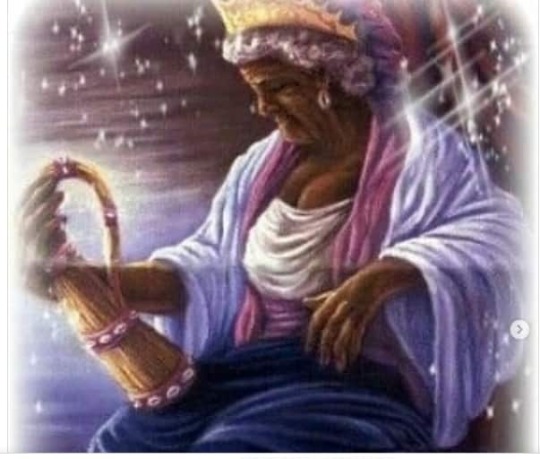
Nana Buluku is a prominent deity famous in most West African nations. She also has different names in various tribes. Nana Buluku is worshipped as the mother goddess. Her image is that of an older woman who is thought to be the creator of the world.
7. Abena
Known as the river goddess, Abena shields children and looks after them as adults as she perceives her believers as her children. Her name is associated with gold, brass, as well as with other wealth symbols.
8. Oduda
Oduda is among the African goddess names and meanings venerated by the North-West African community in Benin, Yoruba, and Dahomey. Her name Oduda means 'the black one,' and her appearance is that of a serpent. Oduda is the deity behind sacred prostitution that is practiced in the Caribbean Islands.
9. Inkosazana
Inkosazan, which means 'lady heaven,' is a prominent and adored goddess of the Zulu community in South Africa. She is thought to be responsible for corn, one of the vital dietary supplements in the Zulu tribe.
10. Age-Fon
Other than the African goddesses, there are gods that cannot go unmentioned in this piece. Age–Fon is a god in Benin, whose power and fame goes as far back to the Dahomey Empire. He is the son of the creator goddess Mawu-Lisa. Age can protect and lead hunters in their hunting expeditions, whether at night or during the day. Besides, he also guides and safeguards his tribesmen in times of battles and wars. It is alleged that Age replenishes his energy and power from his mother. His image is that of a young lad wearing hunter's clothing. To honor Age-Fon, hunters sacrifice to him fleshy parts of the animals they hunt.
11. Kibuka
Kibuka is the god of war in the Buganda Empire kingdom. It is believed that Kibuka has been with Buganda's since the 9th century, even before the arrival of the Europeans in the country.
After The Bugandan military encountered many defeats, its king met with the Creator, Mukasa, to seek help to defeat his enemies. It is here that Mukasa gave them his younger brother Kibuka to be their god of war. Before embarking on any battle, the army would sing, dance, and offer sacrifices to Kibuka. Kibuka would then go ahead of the warriors to clear their paths and ensure their victory.
12. Adroa
Adroa is a fascinating African god of death for the Lugbara community in Uganda and Congo. He has two characteristics of good and evil. Due to his duality, Adroa's body is divided into two. One of the parts is short and black, symbolizing evil, while the other is tall and white, signifying goodness. Adroa will manifest himself to people in any form that fits the situation at hand. It is also believed that this god appears to individuals before they die.
#African Gods and Goddesses#African Religious Principals#12 famous African goddesses and gods with mind-blowing history
101 notes
·
View notes
Note
do you have any recs for folklore/mythology books to learn from or docs/videos?
I have tonnes!!! I prefer non-fiction books when it comes to mythology, with the exception of American Gods and Anansi Boys by Neil Gaiman, and Things Fall Apart by Chinua Achebe. This one is more history focused but it blends the mythology and culture of Nigeria/Igbo folklore. I would recommend it to anyone just looking for a really good book to read about culture, history, the perception of masculinity within that culture, and of course, the negative effects of colonisation, and the history of pre-colonisation in Nigeria. It's one of my favourite history books by a really amazing author and poet! Def recommend.
I tried to focus on mythology that is not as widely popularised as others since they are often harder to find. But here are some of the ones that I enjoyed! Most of them were available at my public library as well so if you can't find them in stores or online, that's always another good place to look for mythology books/refs!
Books:
Myths from Mesopotamia by Stephanie Dalley
Voices from the Other World: Ancient Egyptian Tales by Naguib Mahfouz
Conceptions of God in Ancient Egypt: The One and the Many by Erik Hornung
Indaba, my Children: African Folktales by Vusamazulu Credo Mutwa (this is a massive encyclopedia at 700 pages but sooooo worth it!)
Folktales from India by A.K. Ramanujan
Myth = Mithya: Decoding Hindu Mythology by Devdutt Pattanaik (also: The Goddess in India: The 5 faces of Eternal Feminism, 99 thoughts on Ganesha: stories, symbols and Rituals of India's beloved Elephant Headed Deity, and the Pregnant King are really good)
Myth and Reality: Studies in the Formation of Indian Culture by Damodar Dharmananda Kosambi
The Ramayana & Mahabharata by Chakravarti Rajagopalachari (these are epics but OH GOD they are fantastic!)
Irish Mythology - this is a massive tumblr reference with books and guides on where to find Irish Folklore
I've really been enjoying the Chronical Books series on mythology - if only for the illustrations. My favourite so far is Tales of East Africa by Jamilla Okubo, Tales of India: Folktales from Bengal, Punjab, and Tamil Nadu by Svabhu Kohli and Viplov Singh. I wouldn't really say these are super important for mythology - the stories are very basic (not in a bad way at all, just less in-depth since I believe the books are geared toward a younger audience) but the art alone makes them worth it!
Mythology by Edith Hamilton is usually a good introduction to Greek, Roman, and Norse myths
The Prose Edda: Tales from Norse Mythology by Snorri Sturluson
Videos:
Trese on Netflix - it's about Philippine mythology told in modern times, and just an amazing show on its own!
The Entire Story of Greek Mythology Explained - it's 3.5 hours but WORTH IT!
I don't really watch too many videos on mythology, but I do on history and culture. It's just kinda hard to find mythology/folklore specific videos but since it's often interwoven within the cultures respective history, I watch Smithsonian docs on their history instead.
I really hope this helps!!!
#if anyone else has any others to add please do so!!#and before i had disposable income#there's the wikipedia rabbit hole#and tourism pages!
22 notes
·
View notes
Note
You say you're willing to write for a variety of fandoms and material, one being Greek mythology. Do you have any ideas you don't mind sharing?
@palettesofrenaissance I had to dig up this relic to respond to you. I had done a short writing in the past that was a bit of a crossover between Nigerian mythology and Greek mythology, wherein the Igbo Supreme Creator Goddess would be minding her business and Zeus would try... Well we all know how Zeus is, but yeah it backfired on him immensely. I've never posted or shared it anywhere and it's unedited (and Idk how old) so please disregard the typos, but here it is.
Zeus, Olisabuluwa
How The Heavens Split
It was a fatal mistake. One that the pantheon could only sit by and watch helplessly. Zeus was the God of Gods, champion of all... Yet and still wasn't prepared for her. Maybe it was his brashness or his ego and certainly his extreme lust and lack of self control that destroyed everything. Zeus just absolutely had to have her, but this time, it proved to be his downfall.
"Olisabuluwa". That was one of the names that they called her in her home world. She was ancient and all powerful, having birthed the Sun, the Moon, and the Universe that she came from. Having retired, she merely traveled and observed those in different universes for leisure now. It's a shame that the narcissistic hunger that composed Zeus's personality resulted in such raw nympholepsy that he didn't even note the power of what he thought was a normal woman.
She was beautiful and dark skinned, long, high-end fabrics conservatively shielding her body, and himation covering her head, her soft figure easily desirable by anyone's standards. She lived modestly in a small home made of brick far out in the countryside, with a pond and under an acre of farmland, just enough to sustain herself. She was ever reclusive, coming out only on the morning of the full moons to give away free goods to peasants and helots.
Zeus had spotted her beauty while disguised, in the midst of one of his other... Conquests. The woman whose home he was leaving was near to where merchants gathered to peddle their wares. On this day, Olisabuluwa had a 4 wheeled cart loaded with various food items and crops from her farm, pulled by a pair of oxen. As if her beauty and sun-loved skin wasn't enough to grab his attention, Zeus realized that she was from a foreign land by virtue of the small clay pots that she was giving away. They certainly weren't Greek and neither were most of the dishes contained within them. He should have been intrigued by that, if not alarmed as a God, that a foreigner of this nature had materialized seemingly over night and had been there for a few years without any of the Gods or Demigods knowing. But he wasn't.
He saw her then and approached, using his best, most handsome human form, introducing himself as Zeus. He complemented her gorgeous eyes-- the color of healthy earth and her hair-- appearing plush as a cloud, but to no avail. She firmly, but respectfully declined until she was forced to harshly demand that he leave her space.
It infuriated him to no end, not that she said no (He would have her regardless so that didn't matter), but that she was in his opinion, stupid enough to decline an immaculate and well-spoken God.
Zeus went on then, to disguise himself as a poor child, gathering information on the mysterious woman. He waited for the next full moon, disguising himself as an owl-- an animal considered to have her favor, and followed her out to her home amidst the plains of blue and white flowers of the open countryside. Were he not so ignorant and trapped in his own megalomania he would have noticed the blue flowers and recognized the symbolism of them and the wisdom of the owls to Olisabuluwa. Common knowledge across the different pantheons.
As she lit the flames of her outdoor lanterns for the night he attempted to attack her, swooping down from high in the sky in owl form and landing on top of her in the form of a man. She didn't scream or struggle, instead posing a question, "Are you certain of your choice?" He responded with using his mighty strength to tear away some of her clothing. He should have been concerned about her non-reaction, but he was too drunken on his own arousal.
Zeus motioned to violate her body and penetrate her, but it never came to fruition. Suddenly her eyes became like mirrors that reflected her own universe and the world shook on Atlas' back. Olisabuluwa's body dissolved into the form of this Universe and Zeus was swarmed by the energy of the cosmos themselves as reality fell away from him. He found the world shrinking in his view as she carried him faster than light further and further away from the human world. The pantheon watched in horror as Olisabuluwa crashed Zeus back into his place on his throne in the Heavens, releasing his God power into the mortal realm, before using her power as a Supreme Being to rend them apart.
The Heavens tore, completely apart from the human world and then again and again it was shredded into shards, tattering and dissolving into the rest of the Universe. The Greek gods were now separated from each other and their subjects. And one thing that was common knowledge about the Greek gods, was that they needed access to the worship of their mortals to survive.
Technically, the Heavens and such could be restored. But Olisabuluwa certainly would not be the one to do it. And as for Zeus. Zeus was dead. His power released upon his mortals that they may all wake up and be gods themselves. They soon will cease to rely on their pantheon.
If only Zeus were not so foolhardy. He would have known better than to execute his usual pattern of behavior and minded his targets. Instead, all of his home dimension must live with the folly of his ways.
3 notes
·
View notes
Text
Black Gods and Goddesses: 6 Mythological Figures of the African Cultures - Spotcovery
Anansi the Trickster Spider
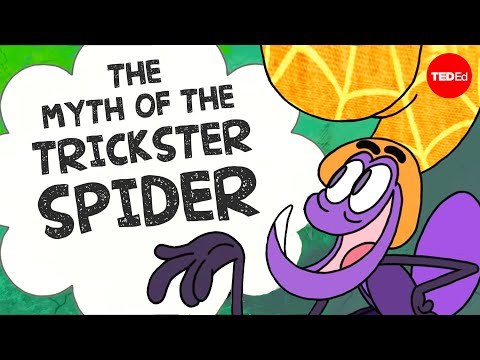
Anansi is a black god that usually appears as a spider but can take on human form. It’s a central mythological figure in the tradition of most West African cultures, especially among the Akan people of Ghana and the Ashanti region. He’s known as the spirit of all tales and knowledge.
Modjadji
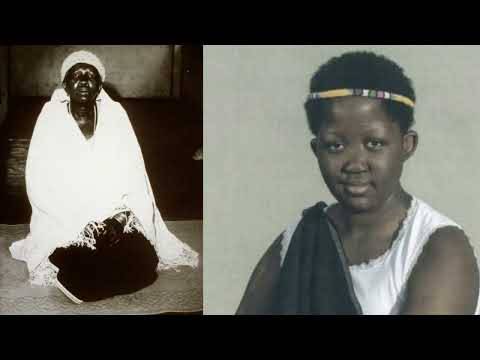
Queen Modjadji, also known as the Rain Queen is South Africa’s rain goddess. Modjadji spirit dwells in the body of a young lady who’s seen to be the queen of the Balobedu ethnic group. The people of Balobedu believe that the rain queen has the power to control the clouds and rainfall.
Amadioha

Another popular mythological figure of African culture is Amadioha. He’s the Agbara or arusi (spirit worshiped in Igbo land) of the thunder and lightning of the Igbo people of southeastern Nigeria.
Amadioha is known as the god of justice. He talks through thunder and strikes through lightning. Anyone found guilty by Amadioha is usually killed by lightning.
Mami Wata

When you think of beauty and attractiveness, Mami Wata has them in abundance. Mami Wata is a water spirit worshiped in Central, West, and Southern Africa and in the Afro-American diaspora. She has a female human upper and a serpent or fish lower part.
Mami Wata represents good fortune, wealth, healing, and the threat of destruction to those who go against her rules. She’s celebrated and worshiped in rivers through rituals of music and dance. Many books on Amazon can teach you more about Mami Wata.
Loa
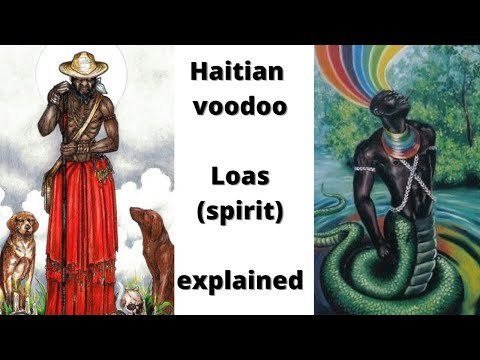
Iwa, also known as Loa, serves as the mediator between humanity and the divine. In their thousands, they guide, heal, and protect the loyal followers of the voodoo tradition.
Voodoo is a region that’s unknown to many people. It’s more associated with witchcraft and devil worship than it’s recognized as a region.
But people who attribute Voodoo and its tradition as satanic are often not aware of its rich folklore and culture. The Voodoo’s thousands of Loa represent years of creativity, intercultural mixing, and spiritual resilience.
Takhar
Takhar is known as the god of justice or vengeance. It’s a demi-god in the Serer religion in Gambia, Senegal, and Mauritania. People worship Takhar so that he can protect them against bad omens, abuse, and injury.
The worshipers offer cattle and poultry as sacrifices to him under the tallest trees. They keep the sacrifices there because they believe that he lives in the upper branches of a tree. The fear of being visited by Takhar prevents people within the Serer religion in Gambia, Senegal, and Mauritania from committing crimes.
Africa is a continent with rich culture and traditions. And the continent’s story is incomplete without the mention of their god and goddesses. The reason is that the people of the African region have always believed in mythological figures. The ones covered here are the most popular ones.
#Black Gods and Goddesses: 6 Mythological Figures of the African Cultures#Black Gods#ATR#African Traditional Religion
4 notes
·
View notes
Photo
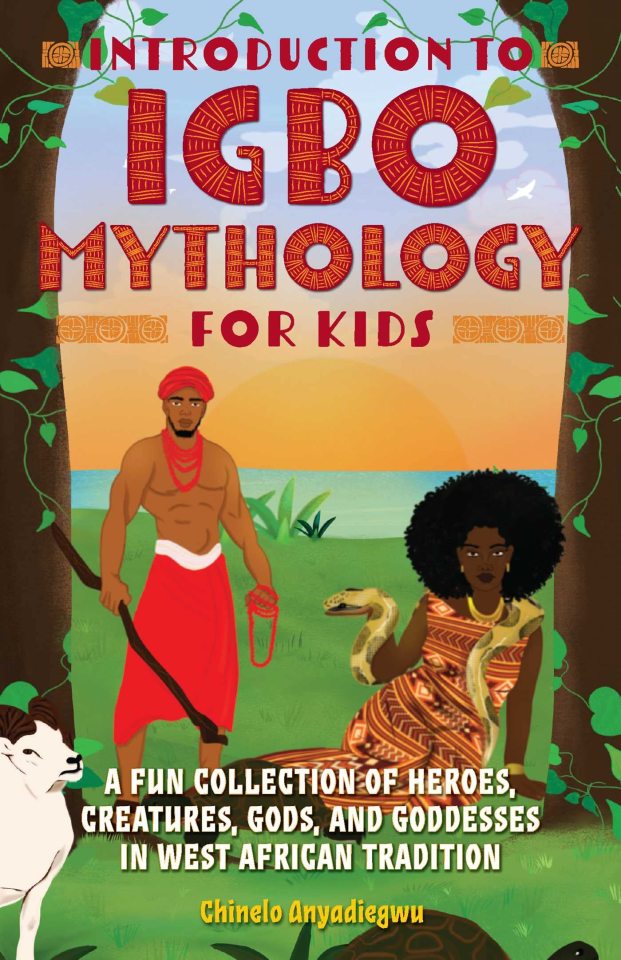
📖Introduction to Igbo Mythology for Kids: A Fun Collection of Heroes, Creatures, Gods, and Goddesses in West African Tradition
Chinelo Anyadiegwu
Ulysses Press
Ages: 10+
Pages: 200
33 notes
·
View notes
Text
WEST AFRICAN RESOURCES
The Anthropological Masterlist is HERE.
West African is an African region that spans the western part of the continent.
AGNIS ─ “The Agnis, or Anyi, people are an African people. They are native to the Ivory Coast.”
─ Anyi Information
AKAN ─ “The Akan people are an African people. They are native to Ghana and the Ivory Coast.”
─ Pre-Colonial History of Ghana
─ Modern-Day Akan
─ Akan Dictionary
ANNANG ─ “The Annang, or Anaang, people are an African people. They are native to southern Nigeria.”
─ Annang Dictionary
ASHANTI ─ “The Ashanti, or Asante, people are an African people. They are native to the Ashanti region in Ghana.”
─ Ashanti Information
─ Ashanti Culture
─ Ashanti History
BAMBARA ─ “The Bambara people are an African people. They are native to West Africa.”
─ Bambara Art
─ Bambara Language (in French)
BASSARI ─ “The Bassari people are an African people. They are native to the Kédougou region of Senegal.”
─ Bassari Language (in French)
EWE ─ “The Ewe people are an African people. They are native to the coastal areas of West Africa.”
─ Ewe Information
─ The Anlo-Ewe People
─ The Adze in Ewe Mythology
FON ─ “The Fon, or Dahomey, people are an African people. They are native to south Benin and southwest Togo and Nigeria.”
─ The Dahomey Amazons
IBIBIO ─ “The Ibibio people are an African people. They are native to the coasts of southern Nigeria.”
─ Ibibio Language Resources
─ Ibibio Masks
IGBO ─ "The Igbo, or Ibo, people are an African people. They are native to Nigeria.”
─ Igbo Culture
─ Igbo Dictionary
ISOKO ─ “The Isoko people are an African people. They are native to the Isoko region in Nigeria.”
─ Isoko Information
─ Isoko Culture and History
─ Isoko Dictionary
KONGO ─ “The Kongo people are an African people. They are native to the Atlantic coast of central Africa.”
─ Kongo Language Resources
─ Kongo Dictionary
KONO ─ “The Kono people are an African people. They are native to the Kono District in eastern Sierra Leone.”
─ Kono Culture and Rituals
NIGERIAN ─ “The Nigerian people are an African people that share the Nigerian culture. They are native to Nigeria.”
─ Nigerian Information
─ Colonial Nigeria
SERER ─ “The Serer, or Seereer, people are an African people. They are native to Senegal.”
─ Serer Information
─ Serer Language
TALLENSI ─ “The Tallensi, or Talensi, people are an African people. They are native to northern Ghana.”
─ Tallensi Culture
─ Tallensi Development and Culture
URHOBO ─ “The Urhobo people are an African people. They are native to the Niger Delta in Nigeria.”
─ Ughelli Kingdom Information
─ Urhobo Dictionary
VODUN ─ “Vodun, or Vodon, is a West African religion. It originates in West Africa.”
─ Christians and Vodun
YORUBA ─ “Yoruba, or Isese, is a West African religion. It originates in southwestern Nigeria.”
─ The Yoruba People
─ Yoruba Culture (in Spanish)
─ Yoruba Mythology
#resources#agnis#akan#annang#ashanti#bambara#bassari#ewe#fon#ibibio#igbo#isoko#kongo#kono#nigerian#serer#tallensi#vodun#yoruba#west african
119 notes
·
View notes
Text
abt me <3 🍰
☆ 18
☆ non-dualism girlieeee w/ a huge ass
☆ 🇳🇬
☆ obsessed w hello kitty, regular show, mythical creatures, n igbo mythology <3
☆ lowkey immortal
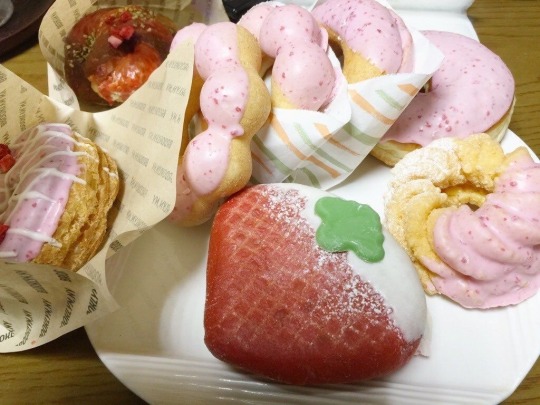
4 notes
·
View notes
Note
Have you thought of names for the fire forest pups yet 😁 ?
It's been consuming part of my conscious and unconscious thoughts a very reasonable amount 🙃
So, the boy's name is up in the air. Maybe I'll go vanilla and keep the family tradition of Jacobs, but meh. Who knows. Any ideas?
BUT FOR THE GIRL!!!!
Ok, full disclosure, I haven't watched a single episode since Lexa's death, and I don't know what happened after that. But I read fics and know that *something* happened, and Clarke ended up with a child named Madi. I see amazing authors writing good stuff with that name, though it doesn't resonate with me.
So I went digging for names.
After a endless rabbit role of baby names and astrophysics, I found "Amadioha", which is "a star named after Amadioha, the god of thunder, justice and peace in Igbo mythology". And guess what her nickname could be 👀 plus representation, out-of-the-box, and a diverse name!
So yeah, I said a bunch of stuff to possibly end with another Madi.
2 notes
·
View notes
Text
idk if anyone's said this before but
(Nona the Ninth spoilers below)
I feel like Nona's school friends aren't actually named what Nona says they're named.
Nona can understand like every language, and I sort of remember at one point she referred to one of her friends (Honesty, maybe?) and Pyrrha (i think) sort of went "huh? oh, right. 'Honesty'," even though she did comment on Hot Sauce having a dumb name.
So I kind of think that Nona is unconsciously "translating" these kids' names. She understands all of earth's languages, and BOE is ostensibly a descendant of the trillionaires, so it makes sense that she would understand.
So for example, lots of names mean "born in the morning". To name a few (just from masculine names alone!):
Anatolius (Greek) - "sunrise" (also the name of a Saint... I'm looking at you, Tamsyn.)
Asahi (Japanese) - "morning sun"
Duha (Arabic) - "morning"
Liwen (Indigenous American/Mapuche) - "morning"
Lucero (Spanish) - "morning star"
Ochieng (Eastern African/Luo) - "born when the sun shines"
Omondi (Eastern African/Luo) - "born early in the morning"
Rameses (Egyptian) - "born of Ra" (Ra being the sun God)
Seong-Ho (Korean) - "daybreak, bright"
Taner (Turkish) - "born at dawn"
Vihaan (Indian) - "dawn, morning"
And that's seriously just skimming through. There's hundreds, if not thousands, of names like that. However, Tamsuir being the deviously complex writer that she is, there are other possibilities I've thought of.
"Born" and "Morning" might be synonyms for other words, or similar in meaning. For example, the sun rises in the east, so perhaps "east" should be a keyword in looking at name meanings. So adding "east" gives even more names, like:
Dong (Chinese) - "east"
Easton (English) - "east town"
"Born" could be a stand in for any number of meanings: creation, God, child (of), etc. Subbing some of these alternate meanings gives even more:
Ansbert (Germanic) - "God, bright"
Chikere (Western African/Igbo) - "God created"
Christopher - "bearing Christ"
Elior (Hebrew) - "my God is light"
Godabert (Germanic) - "God, bright"
Huangdi (Chinese Mythology) - "yellow, god, emperor"
Orel (Hebrew) - "light of God"
Osbert (English) - "god, bright"
Sabah (Egyptian) - "born in the morning"
Sabah ad-Din (Arabic) - "morning of religion"
Uriel (Hebrew) - "God is my light"
A synonym of "born" is also "indigenous", and indigenous people and cultures are definitely a reoccurring theme in her naming conventions. So maybe instead of looking for different combinations of synonyms for "born" and "morning", I should instead be looking at indigenous names that mean "morning". Unfortunately I'm not sure where to find a reliable database for indigenous (particularly Maori) names and meanings, so I couldn't find any names that fit my keywords. :(
@ser-jebibbiga and @madame-ambamba-jombes i might need ur help with this next one <3
There's also, always, the Biblical names that have a suspiciously close meaning or story. These are, admittedly, a bit of a stretch. A very brief search (from a non-religious personal who is fairly clueless about scripture) only gave me Jonathan.
Jonathan (Hebrew, Old Testament) "Yahweh has given" (Yahweh being the Hebrew word for God)
Jonathan was the oldest son of Saul. Oldest -> earliest -> morning... born in the morning. Listen-- Jonathan's relationship to his father was strained due to his close relationship with his father's rival David. Born in the Morning's fathers are not, as far as I remember, big fans of Nona (conceptually, re:necromancers and Jod). I'm also fairly certain that Born in the Morning's eight(?) fathers could really help narrow down this search, but I'm not familiar enough with scripture to put it to much use.
So. That's just for Born in the Morning, and none of those lists are at all expansive. It's just passive research into it.
I kind of wanna do a similar deep dive into the others' names but it is currently 5:30pm and I am Hungry.
So yeah idk. Thoughts?
#nona the ninth#nona the ninth theory#nona the ninth naming#nona the ninth spoilers#locked tomb spoilers#locked tomb#born in the morning#locked tomb naming#mine
9 notes
·
View notes
Text
Mami Wata
Mami Wata (Mammy Water), or La Sirene, is a water spirit venerated in West, Central, and Southern Africa and in the African diaspora in the Americas. Mami Wata spirits are usually female but are sometimes male.
The appearance of her hair ranges from straight, curly to kinky black and combed straight back. Most scholarly sources suggest the name "Mami Wata" is a pidgin English derivation of "Mother Water", reflecting the goddess's title ("mother of water" or "grandmother of water") in the Agni language of Côte d'Ivoire, although this etymology has been disputed by Africanist writers in favor of various non-English etymologies, for example, the suggestion of a linguistic derivation from ancient Egyptian and Mesopotamian, such as the Egyptian terms "Mami" or "Mama", meaning "truth" "Uati" or "Uat-Ur" for "ocean water". While the exact context of the etymology has been challenged, the purpose of Mami Wata's name derived from pidgin English is to both distinguish her "otherness" and connection with the African and African diaspora. Mami Wata is understood to be a foreign spirit by Africans, and the recognition of her and her name is also a recognition of Africans comprehending worlds other than their own.

A participant at a Mami Wata coming out ceremony.
Historical evidence for such deep antiquity of the goddess's tradition has never been offered. Commonly thought to be a single entity, the term has been applied to a number of African water deity traditions across various cultures. These African cultures were often matriarchal and though "Mami Wata" can refer to both male and female deities, they are most typically thought of as feminine and most often take on a female form in artistic representations.
Mami Wata is often described as a mermaid-like figure, with a woman's upper body (often nude) and the hindquarters of a fish or serpent. In other tales, Mami Wata is fully human in appearance (though never human). The existence and spiritual importance of Mami Wata is deeply rooted in the ancient tradition and mythology of the coastal southeastern Nigerians (Efik, Ibibio, Igbo, Bahumono and Annang people). Mami Wata often carries expensive baubles such as combs, mirrors, and watches. A large snake (symbol of divination and divinity) frequently accompanies her, wrapping itself around her and laying its head between her breasts. Other times, she may try to pass as completely human, wandering busy markets or patronising bars. She may also manifest in a number of other forms, including as a man. Traders in the 20th century carried similar beliefs with them from Senegal to as far as Zambia. As the Mami Wata traditions continued to re-emerge, native water deities were syncretized into it.
While commonly seen with a mirror in hand, Mami Wata is able to embody ritual performances and worship ceremonies for Africans through this instrument. Her mirror represents a movement through the present and the future; her devotees are able to create their own reality through imaging of themselves in their own recreation of Mami Wata's world. In this world, one can embody her sacred powers, fulfilling the inventions of their own reality.
Traditions on both sides of the Atlantic tell of the spirit abducting her followers or random people whilst they are swimming or boating. She brings them to her paradisiacal realm, which may be underwater, in the spirit world, or both. Should she allow them to leave, the travellers usually return in dry clothing and with a new spiritual understanding reflected in their gaze. These returnees often grow wealthier, more attractive, and more easygoing after the encounter.
Van Stipriaan further reports that other tales describe river travellers (usually men) chancing upon the spirit. She is inevitably grooming herself, combing her hair, and peering at herself in a mirror. Upon noticing the intruder, she flees into the water and leaves her possessions behind. The traveller then takes the invaluable items. Later, Mami Wata appears to the thief in his dreams to demand the return of her things. Should he agree, she further demands a promise from him to be sexually faithful to her. The agreement grants the person riches; refusal to return the possessions or to be faithful brings the man ill-fortune.
Her worship is as diverse as her initiates, priesthood and worshippers, although some parallels may be drawn. Groups of people may gather in her name, but the spirit is much more prone to interacting with followers on a one-on-one basis. She thus has many priests and mediums in Africa, America and in the Caribbean who are specifically born and initiated to her.
In Nigeria, devotees typically wear red and white clothing, as these colors represent that particular Mami's dual nature. In Igbo iconography, red represents such qualities as death, destruction, heat, being male, physicality, and power. In contrast, white symbolises death, but also can symbolize beauty, creation, being female, new life, spirituality, translucence, water, and wealth. This regalia may also include a cloth snake wrapped about the waist. The Mami Wata shrines may also be decorated in these colors, and items such as bells, carvings, Christian or Indian prints, dolls, incense, spirits, and remnants of previous sacrifices often adorn such places.
Intense dancing accompanied by musical instruments such as African guitars or harmonicas often forms the core of Mami Wata worship. Followers dance to the point of entering a trance. At this point, Mami Wata possesses the person and speaks to him or her. Offerings to the spirit are also important, and Mami Wata prefers gifts of delicious food and drink, alcohol, fragrant objects (such as pomade, powder, incense, and soap), and expensive goods like jewellery. Modern worshippers usually leave her gifts of manufactured goods, such as Coca-Cola or designer jewellery.
Nevertheless, she largely wants her followers to be healthy and well off. More broadly, people blame the spirit for all sorts of misfortune. In Cameroon, for example, Mami Wata is ascribed with causing the strong undertow that kills many swimmers each year along the coast.
According to Bastian, Mami Wata's association with sex and lust is somewhat paradoxically linked to one with fidelity. According to a Nigerian tradition, male followers may encounter the spirit in the guise of a beautiful, sexually promiscuous woman, such as a prostitute. In Nigerian popular stories, Mami Wata may seduce a favoured male devotee and then show herself to him following coitus. She then demands his complete sexual faithfulness and secrecy about the matter. Acceptance means wealth and fortune; rejection spells the ruin of his family, finances, and job.
Another prominent aspect of the Mami Wata deities is their connection to healing. If someone comes down with an incurable, languorous illness, Mami Wata often takes the blame. The illness is evidence that Mami Wata has taken an interest in the afflicted person and that only she can cure him or her. Similarly, several other ailments may be attributed to the water spirit. In Nigeria, for example, she takes the blame for everything from headaches to sterility.
In fact, barren mothers often call upon the spirit to cure their affliction. Many traditions hold that Mami Wata herself is barren, so if she gives a woman a child, that woman inherently becomes more distanced from the spirit's true nature. The woman will thus be less likely to become wealthy or attractive through her devotion to Mami Wata. Images of women with children often decorate shrines to the spirit.
The people who inhabit the coastal region from Benin, Ghana and Togo worship a vast pantheon of water deities, of which Mami Wata is most prominent. An entire hierarchy of the Mami Wata priesthood exists in this region to officiate ceremonies, maintain the shrines, conduct healing rituals, and initiate new priests and priestesses into the service of various Mami Wata deities. On February, 15, 2020 at 9:00 AM in the city of Cotonou, Benin, Hounnon Behumbeza, a high priest of Vodou and Mami Wata, was officially appointed the Supreme Chief of Mami Wata. As an indication of how revered Mami Wata is in the region, Hounnon Behumbeza's coronation as Supreme Chief of Mami Wata was broadcast live on various television news programs, and featured in local newspapers. The coronation was attended by hundreds of priests from around the region, and the highest dignitaries of Vodou and the Mami Wata tradition. Also in attendance were Benin Republic's minister of culture and several local government officials.
Social disparities in West Africa diffused the belief of individual contracts with spirits as the cause of personal wealth and success in earthly life. Mami Wata embodies the power of money, wealthy and fame acquired in the absence of ethical laws and obligations to the neighbour. The unique exception is a lifelong contract somewhere read as private investment or as long-term debt that can be extinguished or promised without being fulfilled.
As other deities become absorbed into the figure of Mami Wata, the spirit often takes on characteristics unique to a particular region or culture. In Trinidad and Tobago, for example, Maman Dlo plays the role of guardian of nature, punishing overzealous hunters or woodcutters. She is the lover of Papa Bois, a nature spirit.
It is believed that all of ancient Africa possessed a multitude of water-spirit traditions before the first contact with Europeans. Most of these were regarded as female. Dual natures of good and evil were not uncommon, reflecting the fact that water is an important means of providing communication, food, drink, trade, and transportation, but it can drown people, flood fields or villages, and provide passage to intruders. Van Stipriaan suggests that she may be based on the West African manatee, which is an idea that has been proposed by scientists of the Ghanaian Council for Scientific and Industrial Research (CSIR); in fact, "Mami Wata" is a common name for this animal in the region. Jill Salmons argues that the mermaid image may have come into being after contact with Europeans. The ships of traders and slavers often had carvings of mermaid figures on their prows, for example, and tales of mermaids were popular among sailors of the time. On the other hand, white is traditionally associated with the spirit world in many cultures of Nigeria. The people of the Cross River area often whiten their skin with talcum or other substances for rituals and for cosmetic reasons, for example.
Van Stipriaan speculates that Liberian traders of the Kru ethnic group moved up and down the west coast of Africa from Liberia to Cameroon beginning in the 19th century. They may have spread their own water-spirit beliefs with them and helped to standardise conceptions in West Africa. Their perceived wealth may have helped establish the spirit as one of good fortune.
According to Hounnon Behumbeza, high priest of the Mami Wata tradition in West Africa (Benin, Togo and Ghana), "The Mami Wata tradition consists of a huge pantheon of deities and spirits, not just the often portrayed mermaid". Behumbeza goes on to say that "true knowledge and understanding of Mami Wata is shared with those initiated into the priesthood of Mami and with those who hear the calling for initiation into her mysteries."
Van Stipriaan also believes that this period introduced West Africa to what would become the definitive image of Mami Wata. Circa 1887, a chromolithograph of a female Samoan snake charmer appeared in Nigeria. According to the British art historian Kenneth C. Murray, the poster was titled Der Schlangenbändiger ("The Snake Charmer") and was originally created sometime between 1880 and 1887. Dr. Tobias Wendl, director of the Iwalewa-Haus Africa Centre at the University of Bayreuth, was unable to confirm this after extensive searching (as Der Schlangenbändiger is a masculine term, the title seems suspect). He did discover a very similar photograph titled Die samoanische Schlangenbändigerin Maladamatjaute ("the Samoan Snake Charmer (fem.) Maladamatjaute") in the collection of the Wilhelm-Zimmermann Archive in Hamburg. Whichever the original image, it was almost certainly a poster of a celebrated late 19th-century snake charmer who performed under the stage name "Nala Damajanti", which appeared in several variations, particularly "Maladamatjaute", at numerous venues, including the Folies Bergère in 1886. This identification was also made by Drewal in a 2012 book chapter on Mami Wata. Despite exotic claims of her nationality, she was later identified as one Émilie Poupon of Nantey, France.
This image—an enticing woman with long, black hair and a large snake slithering up between her breasts, ambiguous if she is human or mermaid beyond the image—apparently caught the imaginations of the Africans who saw it; it was the definitive image of the spirit. Before long, Mami Wata posters appeared in over a dozen countries and the popular image was reproduced in 1955 by the Shree Ram Calendar Company in Bombay for the African market. People began creating Mami Wata art of their own, much of it influenced by the lithograph.
21 notes
·
View notes
Text
I am about to share with you my absolute favorite naming resource. It’s called behindthename.com and has SO MANY names, organized by culture/region. Have you ever needed 180 Basque names, or 114 Igbo names? How about Low German, or Shawnee? Aboriginal Australian or Phoenician? Not to mention all the mythology categories. Do yourself a favor and check this out.
14 notes
·
View notes
Note
I’ll give you one (1) badger boi for all of their full names, orientations, backgrounds, roles, powers, family members, relationship status, and blood types /j
🦡
But fr that’s so cool I’d like to know as much as you’re willing to share!
DAKSJLFHASDJKLFASDF i’d love to share some basic info!!! gonna go into more detail below the cut, but the basic gist of the story is that there’s 6 main friends and a few other characters, and they have their irl identities and their ‘flower power’ personas, so they basically lead double lives- at day they just go to school and are normal kids, but (in their world there’s no nighttime, there’s just day and afterday which is like. night without the night idk it’s weird) during the afterday, they use their powers to help queer kids on the streets! it’s in a dystopian world where the government specifically targets queer kids on the streets, and it’s pretty interesting!!
aiviri- this is aiviri! her pronouns are she/fae/fleur, and fae’s a Black autistic femme lesbian! she’s very soft-spoken but strong-willed, and fleur expresses herself through her music and songwriting! she has the power of growing and manipulating flowers and ivy (hence faer name, aiviri, which means ivy in igbo!)
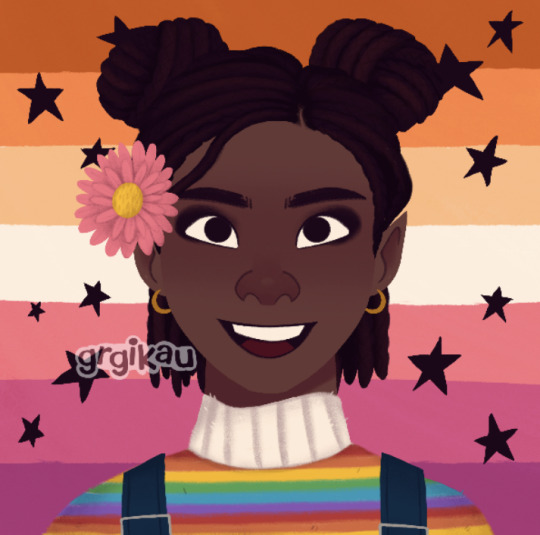
🌻🌻🌻🌻🌻🌻🌻🌻🌻🌻🌻🌻🌻🌻
juniper- juniper is a nonbinary transfem lesbian, they/xe/she, and they’re also a tomboy! she’s a physically disabled Black anarchist, and loves science, robotics, reading and writing science fiction, and engineering! xe is quite outgoing with friends but shy with others, and has a younger sister named nia!

🌻🌻🌻🌻🌻🌻🌻🌻🌻🌻🌻🌻🌻🌻
xander/ash- this guy is a genderpunk nonbinary transmasc butch aro lesbian, and his pronouns are he/they! they love the punk subculture, punk rock music, alternative music and culture, and anarchism! he’s the leader of his school’s bsu, and he’s very protective of their friends! he’s a fiercely loyal and wonderful person overall, and his power is reading peoples intentions and reading reality beyond illusions, and he can sense imminent danger! he’s the adoptive older brother of symphoni!

🌻🌻🌻🌻🌻🌻🌻🌻🌻🌻🌻🌻🌻🌻
evelyn/willow- willow is an ace transfem sapphic who uses she/her pronouns! she’s passionate about the environment, gardening, flowers, forest conservation, fostering indigenous plants and flora, and she also loves mythology! she’s an indigenous Irish traveller and her power is mastership over movement, agility, and deception using her body!

🌻🌻🌻🌻🌻🌻🌻🌻🌻🌻🌻🌻🌻🌻
harley/meadow- an Irish nonbinary lesbian who uses they/she/he pronouns, harley is autistic and has a special interest in biochemistry! they’re into cyberpunk, ethereal aesthetics, singing, dancing, and have the power of making fictional worlds real and creating illusions with her mind!
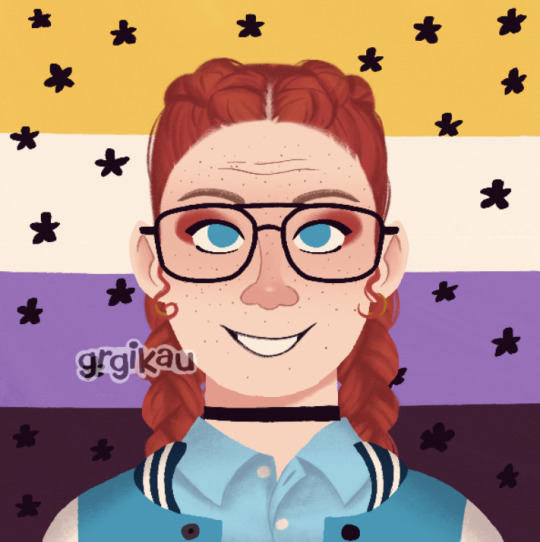
🌻🌻🌻🌻🌻🌻🌻🌻🌻🌻🌻🌻🌻🌻
zohra- a very sweet and loyal autistic femme aroace lesbian! they use they/fey pronouns, and are a wonderful, masterful artist and painter! fey is a writer who has the power of manipulating time, they’re a timekeeper/time master!!!! very very outgoing and giggly with friends but fairly introverted elsewise!
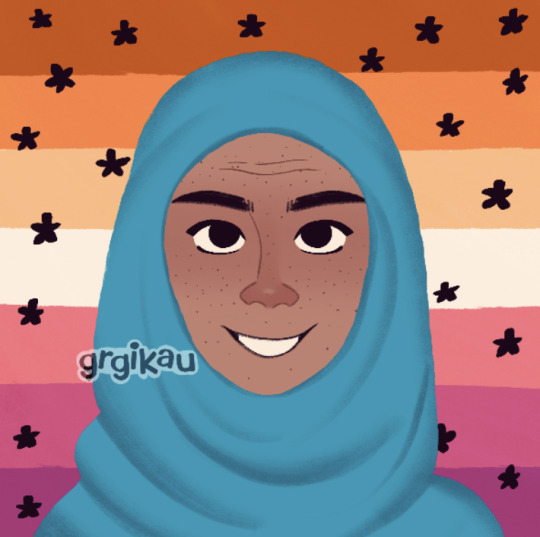
🌻🌻🌻🌻🌻🌻🌻🌻🌻🌻🌻🌻🌻🌻
so yeah :333 there’s more characters but they’re the main 6!!
12 notes
·
View notes
Text
Based on the previous request, I want to host a sort of poll to gauge interest. Please reply with the corresponding emojis (more than one per question is allowed) about what you would like to see.
How often would you like a mythology theme?
❤️ Once a week
💛 Weekends
💚 One theme week once a month
💙 Other (please specify)
And for mythology themes, which are you interested in seeing?
🔴 Greek/Roman
🟠 Norse
🟡 Egyptian
🟢 Slavic
🔵 Celtic
🟣 Chinese
🟤 Native North/South American
⚪ Igbo
⚫ Other (please specify)
I can't guarantee I will hit all of these (or any) but I want to see where interest lies. If you have any other thoughts, feel free to leave them as well! Thank you!
5 notes
·
View notes
